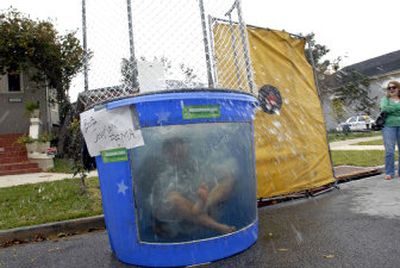New Orleans residents vent via dunking booth

NEW ORLEANS – For $5, residents of one of the city’s hardest hit neighborhoods received three tennis balls Saturday – and a chance to vent 15 months of frustration at the slow pace of rebuilding since Hurricane Katrina.
The object of their annoyance sat perched atop a dunk tank – Bob Josephson, director of intergovernmental affairs in Louisiana for the reviled and much-lampooned Federal Emergency Management Agency.
“C’mon, the water’s warm. Let’s go!” Josephson cried out, as he shivered above the tub of frigid water.
It’s a reminder that in spite of the devastation and lingering anger at government failures, New Orleans maintains its quirky sense of humor. Money raised was to go toward rebuilding efforts in the Broadmoor neighborhood, including planning and community activities.
Nine-year-old Robert Weiss, who lost his toys during Katrina, stepped up and handed over a crumpled $5 bill. In a single, graceful motion, he slammed the ball into the dunking wall, releasing Josephson into the water with a splash. The crowd roared.
In less than an hour, residents shelled out $250 to dunk Josephson. Several took repeat turns.
The dunking booth, a mainstay of county fairs, took on a political dimension a year after the Category 3 storm punched through the city’s protective levees, submerging 80 percent of New Orleans.
Politicians invited to be dunked who politely declined included Mayor Ray Nagin and Gov. Kathleen Blanco. No shows included City Council President Oliver Thomas and the U.S. Army Corps of Engineers, in charge of fixing the city’s levees.
Broadmoor is one of the storm’s few success stories: Sixty percent of the neighborhood’s 2,900 homes are currently occupied and undergoing renovation, one of the highest percentages among the city’s flooded areas. Although it took on between 8 and 9 feet of water, it was one of the first neighborhoods to produce a full-fledged rebuilding plan, as required by the Louisiana Recovery Authority.
Yet the neighborhood also shows the daunting challenges that lie ahead. Behind the dunking booth, red flowers bloomed in the garden of a manicured, fully renovated bungalow. Yet the lawn also had one of the ubiquitous “For Sale” signs, symptomatic of the ongoing exodus from the city.